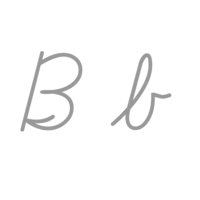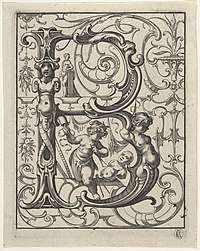B
B or b is the second letter of the Latin-script alphabet. Its name in English is bee (pronounced /ˈbiː/), plural bees.[1][2] It represents the voiced bilabial stop in many languages, including English. In some other languages, it is used to represent other bilabial consonants.
| B | |
|---|---|
| B b | |
| (See below) | |
 | |
| Usage | |
| Writing system | Latin script English alphabet ISO basic Latin alphabet |
| Type | Alphabetic |
| Language of origin | Latin language |
| Phonetic usage | [b] [p] [ɓ] (Adapted variations) |
| Unicode value | U+0042, U+0062 |
| Alphabetical position | 2 Numerical value: 2 |
| History | |
| Development | |
| Time period | unknown to present |
| Descendants | • ♭ • ␢ • ฿ |
| Sisters | Б В בּ ב ب ܒ Բ բ |
| Variations | (See below) |
| Other | |
| Other letters commonly used with | bv bh bp bm bf |
| Associated numbers | 2 |
|
History
| Egyptian Pr |
Phoenician bēt |
Greek beta |
Etruscan B |
Roman B |
Runic beorc |
|---|---|---|---|---|---|
| Uncial B |
Insular B |
Blackletter B |
Antiqua B |
Modern Roman B |
|---|---|---|---|---|
.png) |
 |
Old English was originally written in runes, whose equivalent letter was beorc ⟨ᛒ⟩, meaning "birch". Beorc dates to at least the 2nd-century Elder Futhark, which is now thought to have derived from the Old Italic alphabets' ⟨ 𐌁 ⟩ either directly or via Latin ⟨![]()
The uncial ⟨![]()
![]()
![]()
![]()

The Roman ⟨B⟩ derived from the Greek capital beta ⟨Β⟩ via its Etruscan and Cumaean variants. The Greek letter was an adaptation of the Phoenician letter bēt ⟨𐤁⟩.[3] The Egyptian hieroglyph for the consonant /b/ had been an image of a foot and calf ⟨ ![]()
![]()
By Byzantine times, the Greek letter ⟨Β⟩ came to be pronounced /v/,[3] so that it is known in modern Greek as víta (still written βήτα). The Cyrillic letter ve ⟨В⟩ represents the same sound, so a modified form known as be ⟨Б⟩ was developed to represent the Slavic languages' /b/.[3] (Modern Greek continues to lack a letter for the voiced bilabial plosive and transliterates such sounds from other languages using the digraph/consonant cluster ⟨μπ⟩, mp.)
Use in writing systems
English
In English, ⟨b⟩ denotes the voiced bilabial stop /b/, as in bib. In English, it is sometimes silent. This occurs particularly in words ending in ⟨mb⟩, such as lamb and bomb, some of which originally had a /b/ sound, while some had the letter ⟨b⟩ added by analogy (see Phonological history of English consonant clusters). The ⟨b⟩ in debt, doubt, subtle, and related words was added in the 16th century as an etymological spelling, intended to make the words more like their Latin originals (debitum, dubito, subtilis).
As /b/ is one of the sounds subject to Grimm's Law, words which have ⟨b⟩ in English and other Germanic languages may find their cognates in other Indo-European languages appearing with ⟨bh⟩, ⟨p⟩, ⟨f⟩ or ⟨φ⟩ instead.[3] For example, compare the various cognates of the word brother. It is the seventh least frequently used letter in the English language (after V, K, J, X, Q, and Z), with a frequency of about 1.5% in words.
Other languages
Many other languages besides English use ⟨b⟩ to represent a voiced bilabial stop.
In Estonian, Danish, Faroese, Icelandic, Scottish Gaelic and Chinese Pinyin, ⟨b⟩ does not denote a voiced consonant. Instead, it represents a voiceless /p/ that contrasts with either a geminated /p:/ (in Estonian) or an aspirated /pʰ/ (in Danish, Faroese, Icelandic, Scottish Gaelic and Pinyin) represented by ⟨p⟩. In Fijian ⟨b⟩ represents a prenasalised /mb/, whereas in Zulu and Xhosa it represents an implosive /ɓ/, in contrast to the digraph ⟨bh⟩ which represents /b/. Finnish uses ⟨b⟩ only in loanwords.
Phonetic transcription
In the International Phonetic Alphabet, [b] is used to represent the voiced bilabial stop phone. In phonological transcription systems for specific languages, /b/ may be used to represent a lenis phoneme, not necessarily voiced, that contrasts with fortis /p/ (which may have greater aspiration, tenseness or duration).
Other uses
B is also a musical note. In English-speaking countries, it represents Si, the 12th note of a chromatic scale built on C. In Central Europe and Scandinavia, "B" is used to denote B-flat and the 12th note of the chromatic scale is denoted "H". Archaic forms of 'b', the b quadratum (square b, ♮) and b rotundum (round b, ♭) are used in musical notation as the symbols for natural and flat, respectively.
In Contracted (grade 2) English braille, 'b' stands for "but" when in isolation.
In computer science, B is the symbol for byte, a unit of information storage.
In engineering, B is the symbol for bel, a unit of level.
In chemistry, B is the symbol for boron, a chemical element.
The blood-type B emoji (🅱️) was added in Unicode 6.0 in 2010, and became a popular internet meme in 2018 where letters would be replaced with the emoji.[7]
Related characters
Ancestors, descendants and siblings
- 𐤁 : Semitic letter Bet, from which the following symbols originally derive
- Β β : Greek letter Beta, from which B derives
- Ⲃ ⲃ Coptic letter Bēta, which derives from Greek Beta
- В в : Cyrillic letter Ve, which also derives from Beta
- Б б : Cyrillic letter Be, which also derives from Beta
- 𐌁 : Old Italic B, which derives from Greek Beta
- ᛒ : Runic letter Berkanan, which probably derives from Old Italic B
- 𐌱 : Gothic letter bercna, which derives from Greek Beta
- IPA-specific symbols related to B: ɓ ʙ β
- B with diacritics: Ƀ ƀ Ḃ ḃ Ḅ ḅ Ḇ ḇ Ɓ ɓ ᵬ[8] ᶀ[9]
- Ꞗ ꞗ : B with flourish
- ᴃ ᴯ ᴮ ᵇ : Barred B and various modifier letters are used in the Uralic Phonetic Alphabet.[10]
- Ƃ ƃ : B with topbar
Derived ligatures, abbreviations, signs and symbols
- ␢ : U+2422 ␢ BLANK SYMBOL
- ฿ : Thai baht
- ₿ : Bitcoin
- ♭: The flat in music, mentioned above, still closely resembles lowercase b.
Computing codes
| Preview | B | b | ||
|---|---|---|---|---|
| Unicode name | LATIN CAPITAL LETTER B | LATIN SMALL LETTER B | ||
| Encodings | decimal | hex | decimal | hex |
| Unicode | 66 | U+0042 | 98 | U+0062 |
| UTF-8 | 66 | 42 | 98 | 62 |
| Numeric character reference | B | B | b | b |
| EBCDIC family | 194 | C2 | 130 | 82 |
| ASCII 1 | 66 | 42 | 98 | 62 |
- 1 Also for encodings based on ASCII, including the DOS, Windows, ISO-8859 and Macintosh families of encodings.
Other representations
| NATO phonetic | Morse code |
| Bravo |
 |
|
 |
 |
| Signal flag | Flag semaphore | American manual alphabet (ASL fingerspelling) | Braille dots-12 Unified English Braille |
References
- "B", Oxford English Dictionary, 2nd ed., Oxford: Oxford University Press, 1989
- "B", Merriam-Webster's 3rd New International Dictionary of the English Language, Unabridged, 1993
-

- Schumann-Antelme, Ruth; Rossini, Stéphane (1998), Illustrated Hieroglyphics Handbook, English translation by Sterling Publishing (2002), pp. 22–23, ISBN 1-4027-0025-3
- Goldwasser, Orly (March–April 2010), "How the Alphabet Was Born from Hieroglyphs", Biblical Archaeology Review, Vol. 36, Washington: Biblical Archaeology Society, ISSN 0098-9444
- It also resembles the hieroglyph for /h/ ⟨

- "B Button Emoji 🅱". Know Your Meme. Retrieved 4 December 2018.
- Constable, Peter (30 September 2003). "L2/03-174R2: Proposal to Encode Phonetic Symbols with Middle Tilde in the UCS" (PDF).
- Constable, Peter (19 April 2004). "L2/04-132 Proposal to add additional phonetic characters to the UCS" (PDF).
- Everson, Michael; et al. (20 March 2002). "L2/02-141: Uralic Phonetic Alphabet characters for the UCS" (PDF).
External links



- Giles, Peter (1911), , Encyclopædia Britannica, 3 (11th ed.), p. 87
